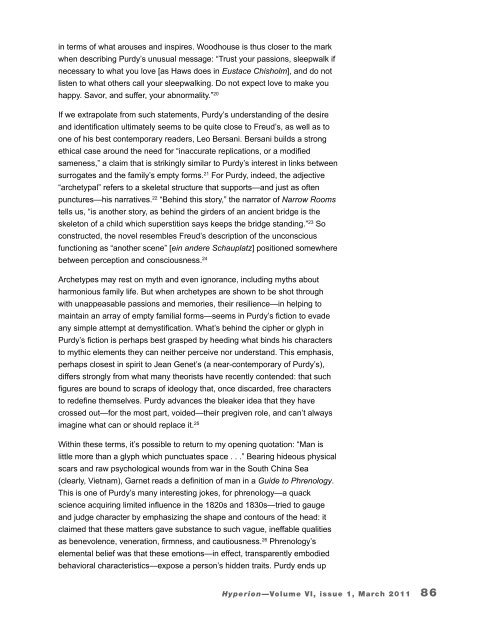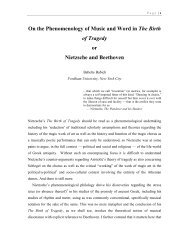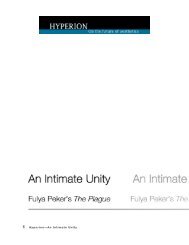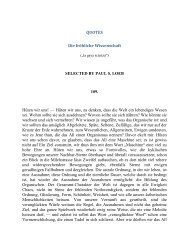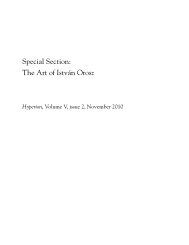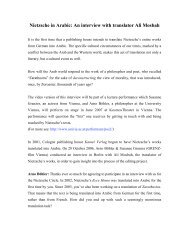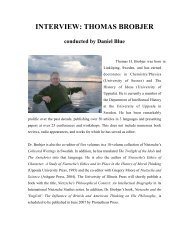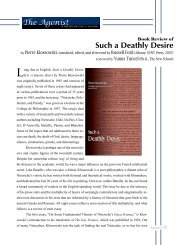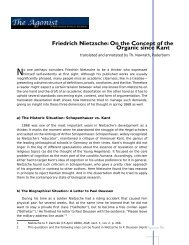Hyperion - Nietzsche Circle
Hyperion - Nietzsche Circle
Hyperion - Nietzsche Circle
Create successful ePaper yourself
Turn your PDF publications into a flip-book with our unique Google optimized e-Paper software.
in terms of what arouses and inspires. Woodhouse is thus closer to the mark<br />
when describing Purdy’s unusual message: “Trust your passions, sleepwalk if<br />
necessary to what you love [as Haws does in Eustace Chisholm], and do not<br />
listen to what others call your sleepwalking. Do not expect love to make you<br />
happy. Savor, and suffer, your abnormality.” 20<br />
If we extrapolate from such statements, Purdy’s understanding of the desire<br />
and identification ultimately seems to be quite close to Freud’s, as well as to<br />
one of his best contemporary readers, Leo Bersani. Bersani builds a strong<br />
ethical case around the need for “inaccurate replications, or a modified<br />
sameness,” a claim that is strikingly similar to Purdy’s interest in links between<br />
surrogates and the family’s empty forms. 21 For Purdy, indeed, the adjective<br />
“archetypal” refers to a skeletal structure that supports—and just as often<br />
punctures—his narratives. 22 “Behind this story,” the narrator of Narrow Rooms<br />
tells us, “is another story, as behind the girders of an ancient bridge is the<br />
skeleton of a child which superstition says keeps the bridge standing.” 23 So<br />
constructed, the novel resembles Freud’s description of the unconscious<br />
functioning as “another scene” [ein andere Schauplatz] positioned somewhere<br />
between perception and consciousness. 24<br />
Archetypes may rest on myth and even ignorance, including myths about<br />
harmonious family life. But when archetypes are shown to be shot through<br />
with unappeasable passions and memories, their resilience—in helping to<br />
maintain an array of empty familial forms—seems in Purdy’s fiction to evade<br />
any simple attempt at demystification. What’s behind the cipher or glyph in<br />
Purdy’s fiction is perhaps best grasped by heeding what binds his characters<br />
to mythic elements they can neither perceive nor understand. This emphasis,<br />
perhaps closest in spirit to Jean Genet’s (a near-contemporary of Purdy’s),<br />
differs strongly from what many theorists have recently contended: that such<br />
figures are bound to scraps of ideology that, once discarded, free characters<br />
to redefine themselves. Purdy advances the bleaker idea that they have<br />
crossed out—for the most part, voided—their pregiven role, and can’t always<br />
imagine what can or should replace it. 25<br />
Within these terms, it’s possible to return to my opening quotation: “Man is<br />
little more than a glyph which punctuates space . . .” Bearing hideous physical<br />
scars and raw psychological wounds from war in the South China Sea<br />
(clearly, Vietnam), Garnet reads a definition of man in a Guide to Phrenology.<br />
This is one of Purdy’s many interesting jokes, for phrenology—a quack<br />
science acquiring limited influence in the 1820s and 1830s—tried to gauge<br />
and judge character by emphasizing the shape and contours of the head: it<br />
claimed that these matters gave substance to such vague, ineffable qualities<br />
as benevolence, veneration, firmness, and cautiousness. 26 Phrenology’s<br />
elemental belief was that these emotions—in effect, transparently embodied<br />
behavioral characteristics—expose a person’s hidden traits. Purdy ends up<br />
<strong>Hyperion</strong>—Volume VI, issue 1, March 2011 86


